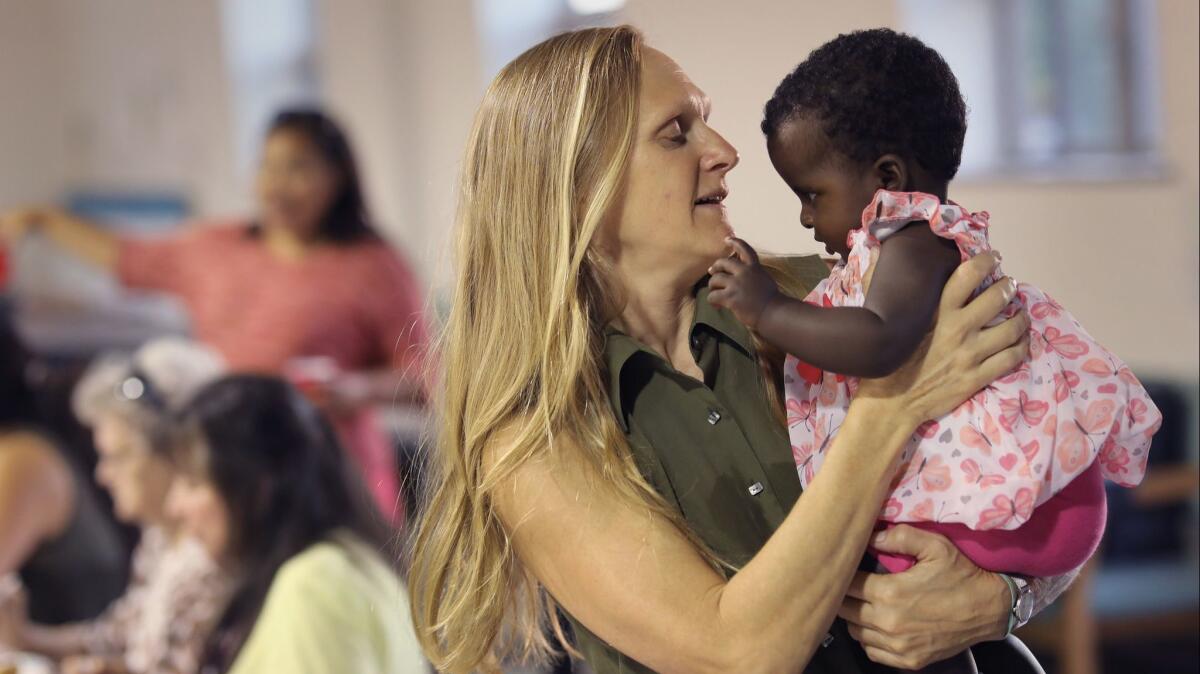Editorial: Slamming the door on the world’s most vulnerable people is contrary to everything America stands for

- Share via
With the announcement Monday that the U.S. would accept no more than 30,000 refugees for resettlement in the coming year, the Trump administration has slammed the door on some of the world’s most vulnerable people — those displaced from their countries, primarily by war or civil unrest — who had hoped to rebuild their lives here free of violence or persecution.
For years, the United States has been the global leader in the number of resettled refugees. Since 1980, the U.S. has set an average annual cap of 94,650 refugees, with a high of 231,000 in 1980 in response to Vietnamese and Cambodian migration. For several years under Presidents George W. Bush and Barack Obama, the cap fell to 70,000, but it climbed back up by the end of the Obama administration to 110,000. Enter Donald J. Trump, who lowered the number to 45,000 this year, and now is slashing the cap again — to the lowest level since the Refugee Act of 1980 was enacted.
In the end, far fewer than 30,000 are likely to be resettled; that number is just a cap. So far this year, the U.S. has accepted a mere 20,000 refugees.
Cutting back on the number of refugees allowed into the country will not help the administration deal with the asylum seekers at its borders.
Secretary of Defense Mike Pompeo announced the reduction to reporters Monday but took no questions. That was unfortunate, because more explanation is necessary. Breaking with past practices, Pompeo lumped refugees with asylum seekers and argued that the U.S. had to cut back on the former in order to deal with the “humanitarian crisis” caused by the latter. He referred to a backlog of 800,000 asylum seekers.
But the two are entirely different groups and are processed differently. Cutting back on the number of refugees allowed into the country will not help the administration deal with the asylum seekers at its borders. The government can set a limit on refugee resettlements, but under the law, asylum requests have to be dealt with as they come. (And saying, as Pompeo did, that the government will process more than 280,000 asylum requests doesn’t mean that many people will receive it. Nearly 60% are rejected.)
Most refugees are first vetted overseas by the United Nations High Commissioner for Refugees and, once referred for resettlement in the U.S., they are vetted again by the Department of Homeland Security and the State Department. No refugees are admitted until they are pre-cleared, a months-long process. Asylum seekers, conversely, often show up at the border unannounced or, if already in the country for other reasons — a student visa, say, or a cultural exchange — seek protection without advance notice. If the asylum seekers make credible arguments to border agents or immigration officials that they fear persecution if sent home, they are allowed to appear before immigration judges for a hearing.
Enter the Fray: First takes on the news of the minute from L.A. Times Opinion »
But reducing the number of resettled refugees does not free up resources for clearing the immigration courts backlog.
The move to reduce the number of refugee resettlements must be viewed within the broader context of this administration’s stingy approach to immigration, from its efforts to ban people from certain mostly Muslim nations to the demands for a wall on the Mexican border — what better symbol of a country shut off from the world than a wall? — to a drop in approved tourism visas and the erosion in the number of people granted citizenship even as applications have increased.
It is true that the nation’s immigration system is broken, and has been for years. Congress has been unwilling to live up to its responsibility to fix it, a dereliction that pre-dates Trump’s time in the White House. But Trump has no interest in reforming the system, or even replacing it. He simply wants fewer immigrants even though the United States needs them in its economic future. And he wants fewer refugees, despite our moral obligation and historical commitment to those who seek our help.
Follow the Opinion section on Twitter @latimesopinion or Facebook
More to Read
A cure for the common opinion
Get thought-provoking perspectives with our weekly newsletter.
You may occasionally receive promotional content from the Los Angeles Times.










